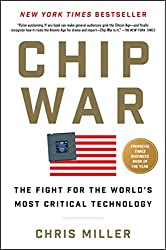
Rating: 8.2/10.
Chip War: The Fight for the World’s Most Critical Technology by Chris Miller
Book about the history of computer chips and international geopolitics that has become entangled with the processes of manufacturing them. The COVID pandemic has highlighted the fragility of the computer chip supply chain: chips require a complex network of hundreds of components to produce, spread across many countries, and each step in the process is highly specialized, so that often there is only one company in the whole world capable of producing it. This book describes the history of how this situation came to be.
The early history of computer chips began in America, with the development of transistors in the 1950s, and soon after, integrated circuits. Early computers were clumsy and inefficient, only suitable for niche use cases, but better processes made them lighter and suitable for usage in space, most notably, the guidance system for the Apollo missions. Fairchild Semiconductor conductor was a pioneer in this space, innovating on processes to manufacture transistors. Early on, the military was the main buyer of chips, and precision guided missiles powered by chips proved to be useful during the Vietnam War; soon afterwards, chips shifted away from military use and towards the consumer market.
While the Americans were developing new technologies, the Soviets tried to set up their own version of Silicon Valley, but by imitating the Americans instead of innovating. Although their spies were quite successful at stealing chips and even chip manufacturing equipment, this copying strategy was unsuccessful, and Soviet technology always lagged several years behind the Americans. Since the Soviet Cold War economy was isolated, it could not benefit from the economies of scale that made the Western chip industry efficient. The chip disadvantage likely played a role in the collapse of the Soviet Union.
During the 1980s, Japan started ramping up on chip production, especially with memory chips. Japanese companies produce chips that were high quality and cheap; the American counterpart, GCA, could not keep up with the competition and eventually went out of business. In Korea, Samsung was fueled by the state and emerged as another Asian competitor. Similarly, in the 1990s, the Taiwanese government was eager to invest heavily in chip development, creating TSMC, which today is the world leader for chip fabrication and plays a crucial part of the chip supply chain. A Dutch company, ASMC, captured the market on lithography tools used in chip manufacturing plants, being the only company in the world capable of producing the highly precise EUV (extreme ultraviolet) equipment necessary to produce modern chips.
Outsourcing chip fabrication was a positive for innovation: chip production required enormous capital investment, whereas chip design required much less capital. Two American companies that benefited from the “fabless revolution” were NVIDIA (specializing in graphics cards), and Qualcomm (specializing in wireless communication chips). Apple is often seen as a hardware company, but it only does the design, iPhone chips are produced by TSMC in Taiwan and assembled in China. Intel became the America’s only remaining domestic chip manufacturer, but its technology is rapidly falling behind Taiwan’s TSMC and Samsung, and it’s doubtful whether it can ever catch up.
Recently, China has been the latest to invest in chip production. Prior to this, China was involved in assembling iPhones, but this is a relatively low margin operation compared to designing and manufacturing chips. Starting in 2014, the Chinese government started making huge investments into chip manufacturing to become globally competitive, even going as far as stealing intellectual property from foreign companies. However, as was the case for the Soviet Union, it is futile to play catch-up – it would take a decade to replicate the existing technology, and by then it would be obsolete, since the competitors would have moved on to newer technologies. Therefore, the only winning play is to develop an essential piece of the global supply chain, which Taiwan, Korea, America and the Netherlands have done. Huawei is threatening to develop the first 5G network, which would be the first indispensable technology only produced in China, threatening the current western-controlled hegemony. Therefore, the Trump administration started a trade war, cutting off Huawei’s supply chain and access to its crucial chips in order to prevent China from gaining the upper hand.
China has been posturing around invading Taiwan, but this is unlikely to happen because both China and America are heavily dependent on Taiwan’s TSMC for chip fabrication. China would like to take control of the TSMC, but the delicate high-tech chip production plant would likely be destroyed in a military operation. Since TSMC is the world’s only producer for many high tech chips, its destruction would set back would set back world chip production by several years, resulting in a shortage far more severe than even the chip shortage of 2021 – a form of mutually assured destruction protecting Taiwan from invasion.
Overall, this is a well-timed book describing the history of the chip industry, how it became globalized, and the current political situation of superpowers jostling over chip supremacy. This supply chain is unique in that it consists of thousands of high-tech components, yet almost every component is produced in only one place and impossible to replace. Last year’s chip shortage has shown the world how fragile this ecosystem is, and this book will help you understand the strategic maneuvering behind the trade war with China.



